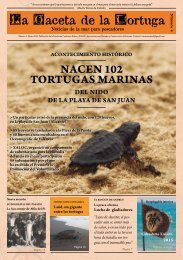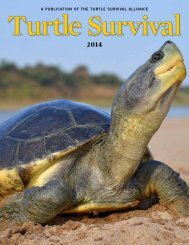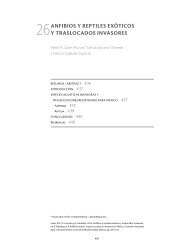tsrp63entire
tsrp63entire
tsrp63entire
You also want an ePaper? Increase the reach of your titles
YUMPU automatically turns print PDFs into web optimized ePapers that Google loves.
Foreword<br />
The former Waikato Conservator of the Department of Conservation (DOC) formally approved<br />
this threatened species recovery plan in 2013. A review of the plan is due in 2017, or sooner if new<br />
information or technology leads to a significant change in management direction. This plan will<br />
remain operative until a new plan has been prepared and approved, or will become redundant if<br />
recovery is achieved and management effort enters a ‘maintenance phase’.<br />
The Native Frog Recovery Group prepared this plan in conjunction with people interested<br />
in or affected by this plan, or with an expert knowledge of these species. Drafts have been<br />
sent to relevant DOC regions for comment and to people or organisations with an interest in<br />
conservation management of native frogs. Changes to the plan were made as a result of that<br />
consultation.<br />
The Recovery Group will review progress in implementation of this plan and will recommend to<br />
managers any changes that may be required in management.<br />
The recovery planning process provides opportunities for further consultation between DOC,<br />
tangata whenua and others regarding management of these species. Comments and suggestions<br />
regarding conservation of native frogs are welcome and should be directed to the Native Frog<br />
Recovery Group via any DOC office or to the Manager, Terrestrial Ecosystems Team (Science<br />
and Capability Group, Department of Conservation, PO Box 10420, The Terrace, Wellington<br />
6143). Those interested in being more involved in management of native frogs or in receiving<br />
information should also contact the Recovery Group.<br />
The Recovery Group consists of people with knowledge of the ecology and management needs<br />
of these species. The role of the Recovery Group is to provide high-quality technical advice that<br />
achieves security and recovery of these species.<br />
Threatened species recovery plans are statements of the Department’s intentions for the<br />
conservation of a particular species of plant or animal, or group of species for a defined period.<br />
Recovery plans:<br />
••<br />
Are proactive and operational in nature, focusing on specific key issues, providing<br />
direction, and identifying recovery actions for managers and technical workers.<br />
••<br />
Set objectives to secure from extinction and recover the species, and outline measurable<br />
actions needed to achieve those objectives.<br />
••<br />
Are primarily used by DOC staff to guide their annual work programmes; however, they<br />
also provide a forum for planned initiatives with tangata whenua, community interest<br />
groups, landowners, researchers and members of the public.<br />
••<br />
Stimulate the development of best practice techniques and documents, which can be<br />
transferable across similar species recovery programmes.<br />
i





